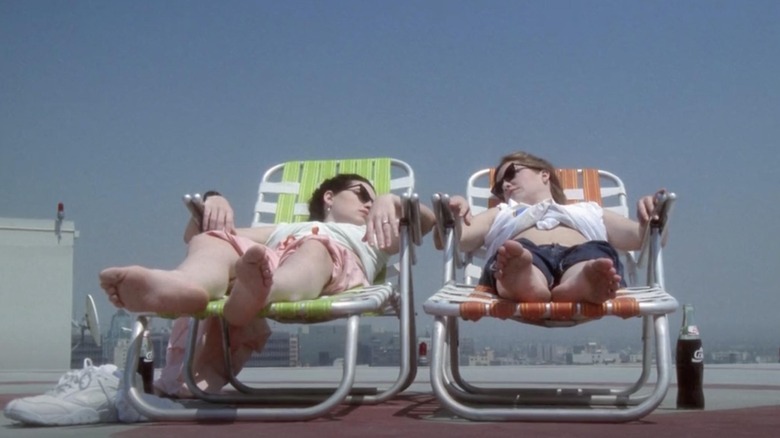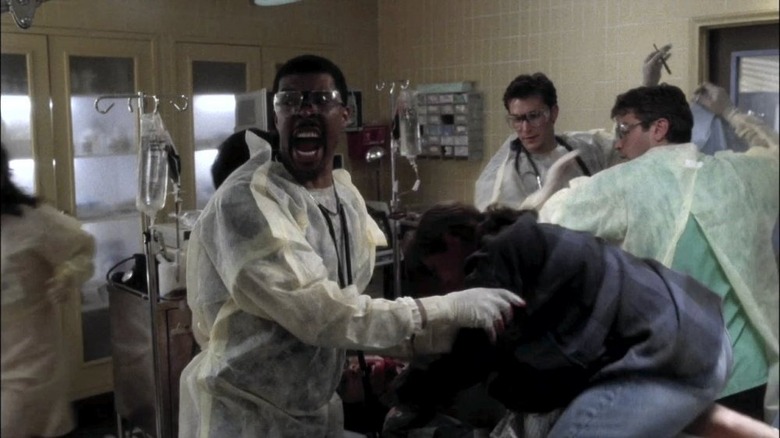With ER, Quentin Tarantino Learned Directing TV Was Different Than Movies
Quentin Tarantino is one of our most renowned cinephiles, as illustrated by his encyclopedic knowledge of film history, genres, and Hollywood stars. He is mostly known for creating audacious films such as "Pulp Fiction" and the "Kill Bill" series. While he has co-directed other movies (such as "Four Rooms" and "Sin City"), it is Tarantino's originals that have left a distinct impact on popular culture.
But did you know that Tarantino has also dabbled in television directing? As "Once Upon a Time...in Hollywood" demonstrated, he is just as savvy about television as he is about film, with a wide knowledge of its unique ecosystem and history. He brought this deep appreciation of television to his work on the eerie two-part season 5 finale of "CSI: Crime Scene Investigation" entitled "Grave Danger" in 2005. When the Los Angeles Times asked the wildly creative director if he felt "trapped by working within the confines of network television," Tarantino confirmed it was a pleasant experience:
"It wasn't a challenge in that regard because [...] I like the show. I just wanted to do my episode of it. So the format was all the stuff I embrace. I just wanted it to be bigger, to feel in someway like a`CSI' movie."
However, his experience working on "ER" season 1, episode 24, "Motherhood," was quite different. Written by supervising producer Lydia Woodward, the episode homages "Reservoir Dogs" by featuring a severed ear and features some gnarly medical trauma to satisfy Tarantino's directorial trademark of bloodlust. Taking place on Mother's Day, the show's medical team handles a playground injury, a mother's death, and a birth. While filming this episode, however, Tarantino found that the process clashed with his usual experience on a movie set.
The producer is 'The Man'
The book "Quentin Tarantino: Interviews" features an interview where the director reflects on his "ER" experience. He previously admired the show's filmmaking style, such as the use of Steadicam shots and long takes lasting over five minutes. When Tarantino got behind the camera, he adopted these techniques but filmed only one take. "We'd do one take and he goes, 'Good, let's move on.' And I said, 'Why are you doing that?' and he said, 'It'll be my cut no matter what!'" Julianna Margulies, who plays Nurse Carol, told Entertainment Weekly. This meant the actors had to do plenty of prepping off-camera to make sure the single take was perfect. This way, the episode wouldn't be changed by NBC.
Tarantino was resisting executive producer John Wells' demand that he reshoot scenes; he was always the one calling the shots on his films. When Tarantino kept wanting to push back, one of the producers said, "Well, who would tell you on your own movie?" This simple question made Tarantino reconsider how directorial authority differs within a television setting:
"This is their show [...] this isn't my show. I'm coming in and I'm directing the episode, and then I'm leaving. In TV, the producer is The Man, the autuer. It was a writer-producer oriented show: all the writers were producers and John Wells was The Man, and it was great."
Tarantino realized that working in television, particularly on successfully pre-established dramas, meant surrendering his full creative control. Instead of creating his own world, he was entering a pre-established one ruled by showrunners, a network, and many other creatives who had the final say. Within this canned environment, rather than his own movie sets, he was unable to let his imaginative vision run quite as wild.

